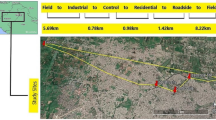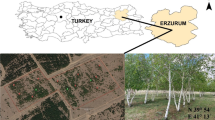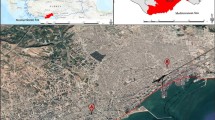Abstract
Heavy metals toxicity is a significant problem for ecological, evolutionary, nutritional and environmental reasons. This study was carried out to evaluate the amount of cadmium, zinc and lead absorption in leaf and root of pine, cypress, plantain and ash in Isfahan, Iran, in 2013. For this purpose, three heavy metals (Cd, Pb and Zn) and three sites (heavy traffic, moderate traffic and control) were chosen based on their effects on human health. The results indicated that the highest and lowest lead and cadmium concentrations belonged to heavy traffic site and control site, respectively. Cd in leaf versus Pb in leaf and Cd in root versus Pb in root had the highest correlation coefficient among the traits indicating positive influence of leaf and root on absorbing Cd and Pb from soil, water and air. In all the studied species, the concentration of Pb was higher than that of Cd and Zn. This was certainty due to the vehicle traffic emitting much more lead than cadmium and zinc. In all the studied species, metal concentration in leaves was higher than in roots, which may be due to high concentration of heavy metals in air than in soil. In this study, Pinus eldarica Medw. tree was found to be the best species to monitor polluted sites in Isfahan city.



Similar content being viewed by others
References
Babaoglu M, Gezgin S, Topal A, Sade B, Dural H (2004) Gypsophila sphaerocephala Fenzl ex Tchihat.: a boron hyperaccumulator plant species that may phytoremediate soils with toxic B levels. Turk J Bot 28:273–278
Bi C, Chen Z, Zheng X (2000) Research progress in rhizosphere heavy metals. Fujian Geogr 15(3):29–32 (in Chinese with English abstract)
Cakmak I, Marshner H (1993) Effect of zinc nutritional status on superoxide radical and hydrogen peroxide scavenging enzymes in bean leaves. In: Barrow NJ (ed) Plant nutrition-from genetic engineering field practice. Kluwer, Dordrecht, pp 133–137
Çelik A, Kartal AA, Akdoðan A, Kaska K (2005) Determining the heavy metal pollution in Denizli (Turkey) by using Robinio pseudo-acacia L. Environ Int 31:105–112
Cheng S (2003) Heavy metals in plants and phytoremediation. Environ Sci Pollut Res 10(5):335–340
Chesworth W (1991) Geochemistry of micronutrients. In: Mortvedt JJ, Cox RR, Shuman LM, Welch RM (eds) Micronutrients in agriculture, 2nd edn. Soil Science Society of America, Madison, pp 1–30
Collins JC (1981) Zinc. In: Lepp NW (ed) The effect of heavy metal pollution on plants, vol 1. Applied Science Publishers, London, pp 145–170
Cooper EM, Sims JT, Cunningham SD, Huang JW, Berti WR (1999) Chelate-assisted phytoextraction of lead from contaminated soils. J Environ Qual 28:1709–1719
Devries W, Lofts S, Tipping E, Meili M, Groenenberg JE, Schutze G (2002) Impact of soil properties on critical concentrations of cadmium, lead, copper, zinc and mercury in soil and soil solution in view of ecotoxicological effects. Rev Environ Contam Toxicol 191:47–89
Fontes RLS, Cox FR (1998) Zinc toxicity in soybean grown at high iron concentration in nutrient solution. J Plant Nutr 21:1723–1730
Ghosh A, Chakrabarti P, Roy P, Bhadury S, Nag T, Sarkar S (2009) Bioremediations of heavy metals from Neem (Azadirachta indica) leaf extract by chelation with dithizone. Asian J Pharm Clin Res 2(1):87–92
Grant CA, Buckley WT, Bailey LD, Selles F (1998) Cadmium accumulation in crops. Can J Plant Sci 78:1–17
Guo J, Dai X, Xu W, Ma M (2008) Over expressing GSHI and AsPCSI simultaneously increases the tolerance and accumulation of cadmium and arsenic in Arabidopsis thaliana. Chemosphere 72:1020–1026
Gupta D, Abdullah A (2011) Toxicity of copper and cadmium on germination and seedling growth of maize. Indian J Sci Res 2(3):67–70
GWRTAC (1997) Remediation of metals-contaminated soils and groundwater. Tech. Rep. TE-97-01, GWRTAC, Pittsburgh, PA, USA, GWRTAC-E Series
Kleckerová A, Dočekalová H (2014) Dandelion plants as a biomonitor of urban area contamination by heavy metals. Int J Environ Res 8(1):157–164
Kord B, Mataji A, Babaie S (2010) Pine (Pinus Eldarica Medw.) needles as indicator for heavy metals pollution. Int J Environ Sci Technol 7(1):79–84
Kwon SH, Torrie JH (1964) Heritability and interrelationship among traits of two soybean populations. Crop Sci 4:196–198
Lehoczky E, Szabó L, Horváth S (1998) Cadmium uptake by plants in different soils. Commun Soil Sci Plant Anal 29:1903–1912
Lehoczky E, Marth P, Szabados I, Palkovics M, Lukács P (2000) Influence of soil factors on the accumulation of cadmium by lettuce. Commun Soil Sci Plant Anal 31:2425–2431
Li X, Poon C, Liu PS (2001) Heavy metal contamination of urban soils and street dusts in Hong Kong. Appl Geochem 16(11–12):1361–1368
Liao S, Chang W (2004) Heavy metal phytoremediation by water hyacinth at constructed wetlands in Taiwan. J Aquat Plant Manag 42:60–68
Lukina N, Nikonov V (1995) Acidity of podzolic soils subjected to sulphur pollution near a Cu–Ni smelter at the Kola Peninsula. Water Air Soil Pollut 85:1057–1062
Minitab (1998) MINITAB 12. Minitab, State College
Mohanpuria P, Rana NK, Yadav SK (2007) Cadmium induced oxidative stress influence on glutathione metabolic genes of Camellia sinensis (L.) O. Kuntze. Environ Toxicol 22:368–374
Moustakas M, Lanaras T, Symeonidis L, Karataglis S (1994) Growth and some photosynthetic characteristics of field grown Avena sativa under copper and lead stress. Photosynthetica 30(3):389–396
MSTAT-C (1990) MSTATC: a Microcomputer program for the design, management, and analysis of agronomic research experiments. Michigan State University, East Lansing
Nabulo G, Oryem Origa H, Nasinyama GW, Cole D (2008) Assessment of Zn, Cu, Pb and Ni contamination in wetland soils and plants in the Lake Victoria basin. Int J Environ Sci Technol 5(1):65–74
Nagajyoti PC, Lee KD, Sreekanth TVM (2010) Heavy metals, occurrence and toxicity for plants: a review. Environ Chem Lett 8:199–216
Pence NS, Larsen PB, Ebbs SD, Letham DL, Lasat MM, Garvin DF, Eide D, Kochian LV (2000) The molecular physiology of heavy metal transport in the Zn/Cd hyperaccumulator Thlaspi caerulescens. Proc Natl Acad Sci USA 97(9):4956–4960
Peško M, Králová K, Masarovicová E (2011) Phytotoxic effect of some metal ions on selected rapeseed cultivars registered in Slovakia. Proc ECOpole 5(1):83–86
Salt DE, Blaylock M, Kumar NPBA, Dushenkov V, Ensley D, Chet I, Raskin I (1995) Phytoremediation: a novel strategy for the removal of toxic metals from the environment using plants. Biotechnology 13:468–474
Salt DE, Smith RD, Raskin I (1998) Photoremediation. Annu Rev Plant Physiol Plant Mol Biol 49:643–668
SAS I: SAS user’s guide. Version 8. (2001). SAS Institute Inc Cary, NC
Shier WT (1994) Metals as toxins in plants. J Toxicol Toxin Rev 13:205–216
Su L, Zhang Y, Lin X, Luo A (2000) Cadmium toxicity and tolerance in vascular plants. Plant Nutr Fert Sci 6(1):106–112 (in Chinese with English abstract)
United Nations Environmental Protection/Global Program of Action (2004) Why the marine environment needs protection from heavy metals, Heavy Metals 2004, UNEP/GPA Coordination Office (http://www.oceanssalts.org/unatlas/uses/uneptextsph/wastesph/2602gpa)
Viard B, Pihan F, Promeyrat S, Pihan JC (2004) Integrated assessment of heavy metal (Pb, Zn, Cd) highway pollution: bioaccumulation in soil, Graminaceae and land snails. Chemosphere 55(10):1349–1359
Vollenweider P, Cosio C, Gủnthardt-Goerg MS, Keller C (2006) Localization and effects of cadmium in leaves of a tolerant Salix viminalis L. Part II. Microlocalization and cellular effect of cadmium. Environ Exp Bot 58:25–40
Vousta D, Grimanins A, Sammara C (1996) Trace elements in vegetable grown in an industrial areas in relation to soil and air particulate matter. Environ Pollut 94(3):325–335
Warne MS, Heemsbergen D, Stevens D, McLaughlin M, Cozens G, Whatmuff M, Broos K, Barry G, Bell M, Nash D, Pritchard D, Penney N (2008) Modeling the toxicity of copper and zinc salts to wheat in 14 soils. Environ Toxicol Chem 27:786–792
Welch RM (1995) Micronutrient nutrition of plants. Crit Rev Plant Sci 14:49–82
Yu G, Zhang X, Liang X, Xu X (2000) Biogeochemical characteristics of metal elements in water-plant system of Lake Dianchi. Acta Hydrobiol Sin 24(2):172–177 (in Chinese with English abstract)
Acknowledgments
We would like to thank Ms. Maryam Sanatgar as she considerably supports this work.
Author information
Authors and Affiliations
Corresponding author
Rights and permissions
About this article
Cite this article
Fatemitalab, R., Zare, M. & Kardar, S. Assessment of cadmium, zinc and lead contamination in leaf and root of four various species. Int. J. Environ. Sci. Technol. 13, 1229–1234 (2016). https://doi.org/10.1007/s13762-015-0931-x
Received:
Revised:
Accepted:
Published:
Issue Date:
DOI: https://doi.org/10.1007/s13762-015-0931-x




